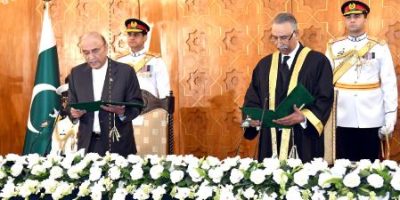Zulfiqar’s very first works displayed at Satrang Art Gallery

Asma Rashid Khan Director Satrang Art Gallery briefed the audience about the salient features of the exhibition
DNA
ISLAMABAD: Satrang Gallery on Wednesday organised – a solo exhibition of Zulfikar Ali Bhutto at Islamabad Serena Hotel. Asma Rashid Khan Director Satrang Art Gallery briefed the audience about the salient features of the exhibition.
Bera Paar is Zulfikar’s very first exhibition in Islamabad and the series of multimedia works in the exhibition are a result of the artist’s long term research project Bulhan Nameh. Zulfikar’s focus is on a particular stretch of the River Indus, in Sukkur, a particularly mystical area with significant shrines and temples. This series of work brings together the nuanced historical and cultural richness of Sindh.

_”Bulhan Nameh is a long term research based project that looks at a selection of sites on the River Indus between Sukkur and Rohri in Sindh, Pakistan. Taking its name for the Sindhi word for the Indus River Dolphin, bulhan, this series intends to look at how in this 10 km long stretch of river punctuated at one end by the British era Sukkur Barrage and at the other by the island shrine of Khwaja Khizr, known locally to Hindus and Muslims as Zinda Pir. Here wildlife, history and spirituality collide with colonialism, capitalism, feudalism, as well as the ever more present modern state. _
Nameh, is a Farsi, Urdu and Sindhi word for diary – this particular diary is written through printmaking and textile. Cyanotypes, analog photographs and archive are paired with traditional Sindhi embroidery as a way to root this project within its current cultural landscape, as well as with memory, nostalgia and a sense of loss. Sukkur is the last place where the river is still full much like She was before the dams and barrages, it is the last refuge of the Indus River Dolphin and a site that evidences syncretic religious practices that still carry on in modern Sindh.
_The Indus is personified as Sindhu Mata, a river that not only gave Sindh its name but also India, Hinduism and all derivatives of these words. In my research I do not intend to expose all elements of the river at this location but instead I hope to re-mystify the Indus and in so doing allow us to re-imagine Her as a living and ever changing entity rather than just an exploitable resource.” _ – Zulfikar Ali Bhutto
Zulfikar Ali Bhutto (b. Damascus, 1990) is an artist and curator whose work resurrects complex histories in the South Asian, South West Asian and North African region. In the process he unpacks the intersections of religion, storytelling, futurity and environmental degradation through a multi-media practice rooted in printmaking, textile and performance. Bhutto has shown work and curated exhibitions globally, as well as spoken extensively on the intersections of faith, radical thought and futurity at Columbia University, UC Berkeley, NYU, Stanford and the Indus Valley School of Art and Architecture. Bhutto is currently based in Karachi, Pakistan and received an MAH in History of Art from the University of Edinburgh in 2014 and an MFA from the San Francisco Art Institute in 2016.
Related News

Islamabad court orders to block 27 prominent YouTube channels over ‘anti-state content’
YouTube channels allegedly involved in spreading material in violation of Peca and other relevant lawsRead More

President Zardari to shortly administer oath to Justice Sardar Sarfraz Dogar
ISLAMABAD, JUL 8 /DNA/ – President Asif Ali Zardari will shortly administer the oath ofRead More


Comments are Closed